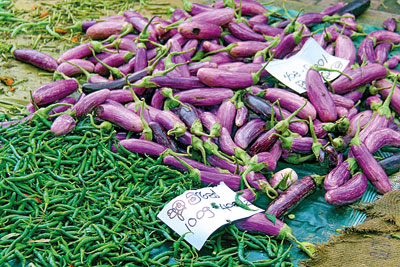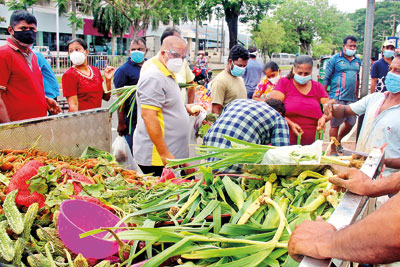News
Little price controls, little options for public hit in the stomach
Prices of essential goods continue to soar with home-bound public forced to pay higher prices whether they are being delivered from the local grocery store, ordered online or bought from mobile vendors.
For many, buying rice was a problem with several rice varieties unavailable in supermarkets, while those available at retail stores were being sold at a much higher price than the government’s gazetted Maximum Retail Price (MRP).

One of the many vegetables gone up in price
Despite the MRP for keeri samba being Rs. 120 per kilo, it was selling between Rs. 140 to Rs. 180 in retail stores. Other Samba varieties that were being sold between Rs. 140-170 while the MRP was Rs. 94. Nadu and red/white raw rice were available while good quality samba was sometimes not available to be even purchased online.
The Hector Kobbekaduwa Agrarian Research Institute said the prices of all local rice varieties had increased due to decreased supply.
In many households, a common breakfast consisting of pulses is hard to afford as green gram sells at Rs. 980 a kilo. In May last year, a kilo of green gram was about Rs. 300. Cowpea prices too remain high with a kilo going at Rs. 730 compared to last year’s Rs. 300. The price of Masoor dhal that was just over Rs. 160 last May is now sold at Rs. 215.
According to the Census and Statistics Department, the average retail price of a kilo of long beans is about Rs. 190 whereas in May last year, it was Rs. 133. Green beans now sells at Rs. 284 while last year it was Rs. 190. Bitter gourd is sold at Rs. 266 whereas it was Rs. 140 last May. Capsicums, butterbeans, luffa, beetroot, radish, ladies fingers, snake gourd, tomatoes, drumsticks, cabbage and carrots too have increased in price compared to last year. (Please see graphic.)
At supermarkets, carrots are sold at about Rs. 300 a kilo, cabbage Rs. 200, brinjals about Rs. 300, capsicums Rs. 400, bitter gourd Rs. Rs. 300, green beans Rs. 400 per, green chillies Rs. 300-400 per and leeks at about Rs.230 per kilo. Fish, meat and dried fish too have increased in price compared to last year. A 425g of canned fish that was Rs. 219 last May is now sold at Rs. 313.
“Now selecting items is not a choice, we buy what is available and affordable. Finding coconuts is also hard, vegetables are costly, meat and fish prices have increased and people are struggling,” said N. Wasantha from Colombo.
“Women in the house are struggling with limited finances; some husbands have had a salary cut. We now worry about the next two weeks with mouths to feed,” said Kusum Ratnayake, a housewife with two schoolgoing children from Kandana.
With disappointed farmers abandoning crops, there is a possibility of vegetable prices increasing even further, said national organiser of the All Ceylon Farmers Association Namal Karunaratne.
“Farmers have abandoned acres of radish, beet crops close to Galewela. Rotting crops can be seen as farmers have given up on cultivating vegetables. Both the lack of a reasonable price and the fertiliser issue have created this situation. People in cities are paying high prices for vegetables when they are bought from our farmers at a low price. It is unfair for both the farmer and the consumer,” he said.
Mr. Karunaratne urged the Government to immediately intervene and make sure that intermediate trader did not make unfair profits.
Meanwhile, the Sunday Times learns that small scale informal sellers are reluctant to enter cities due to lack of documents to prove they are essential services.


Everything comes at a price: A mobile vendor selling vegetables in Moratuwa. Pix by Reka Tharanganie

